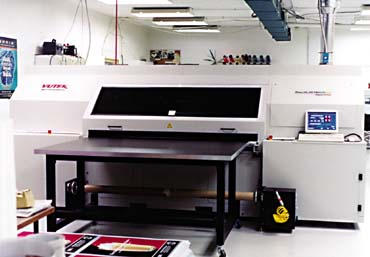Just a couple years ago, screen printing was the only method used to decorate flat glass for architectural purposes. One reason screen printing monopolized this market is its versatility. It can be used for both printing (selectively imaging designs) and coating (complete solid coverage). It also allows for an almost limitless range of deposit thicknesses depending on the ink and requirements of the job.
Just a couple years ago, screen printing was the only method used to decorate flat glass for architectural purposes. One reason screen printing monopolized this market is its versatility. It can be used for both printing (selectively imaging designs) and coating (complete solid coverage). It also allows for an almost limitless range of deposit thicknesses depending on the ink and requirements of the job.
Screen printing also had the unique ability to print ceramic pastes with glass frits and deliver the tough physical properties this application demands. The final performance of the graphic depends upon the ink system the printer selects and the post-print treatment the ink requires. In order to achieve long-term weatherability and light fastness, printers commonly use ceramic pastes, which are fused into the glass at temperatures of approximately 1300°F after printing. Once exposed outdoors, glass printed with ceramic pastes won’t be affected by the climate, even when printed on the first (outside) surface. Other options for glass that don’t provide the same permanence include solvent-based sol-gel inks (which are temperature treated at 392°F) and UV inks (which cure by polymerization).
One disadvantage of screen printing is that every image requires a corresponding screen. Manufacturing these screens involves relatively high expenses for labor (coating, exposing, and developing the stencil) and materials (including frames, chemicals, and screen mesh). Glass printing also demands a relatively large, dust-free area to process and store the screens.
Screen printing remains a cost-effective technique for decorating flat glass for architectural applications, especially when the job entails decorating a number of panes with the same design or selected parts of the image. But, just as it has in other segments of the printing industry, inkjet is carving a role in flat glass decoration. Inkjet presses can be operated by a single person and they eliminate the prepress expense
of screen printing, making the technology cost-effective.
Advertisement
It’s ideal for sampling, manufacturing one-offs, producing short runs, and handling jobs where graphics will be customized or changed slightly from one panel to the next.
The drop-on-demand printhead technology allows substrates to be printed edge to edge, and, as the technology has evolved, the systems have gained in throughput speed to the point that jobs involving a few hundred panes of glass may still fall below the breakeven point at which screen printing would be more economical.
Early digital-printing solutions for architectural glass often involved proprietary systems. In 2007, the building-materials giant Saint-Gobain Glass Solutions installed a custom-built digital printer that used a special type of glass powder instead of ink. The machine was originally developed to print the facade of a new building that would celebrate the audiovisual heritage in the Netherlands.
Around the same time, commercial inkjet systems for architectural-glass applications began hitting the market. Most of the machines that have been introduced use either UV or sol-gel inks, but digital ceramic inkjet printers that can handle glass applications of any size and produce long-lasting, vivid colors that are fused into the glass are also available. The Israeli company Dip-Tech, with several hunded installations worldwide used for interior and exterior architecturtal applications as well as automotive glass, is currently the market leader. “The digital system is a complementary tool to the traditional screen-printing capabilities, rather then being competitive,” says Yariv Ninyo, Dip-Tech’s business development manager. “Since glass manufacturers are basically unfamiliar with the printing process, inkjet printing fits perfectly into their production lines.”
In addition to its inkjet presses, which can image panes of glass ranging from 3.94 x 3.94 to 129.9 x 236.2 inches, Dip-Tech supplies ceramic inks for tempered, fired, annealed, and laminated glass. The company also offers specialized products including slip-resistant inks and conductive formulations for demisters and GPS and radio antennae. The company offers six ink colors (black, white, blue, orange, green, and red), custom color matches, and an etch ink that creates frosted and sandblasted effects without masking. Made of frits, inorganic pigments, and other compounds, these inks mimic CMYK color reproduction and are manufactured under highly controlled conditions to eliminate any deviations in the ink composition.
Two additional inkjet OEMs offer machines designed to print ceramic inks for architectural glass applications – the Spanish company TecGlass and the Austrian manufacturer Durst. TecGlass’s line of Vitro-Jet printers can image glass panes ranging from 14.96 x 14.96 up to 129.92 x 47.24 inches, and feature IPT technology that prints and dries the inks simultaneously. The machines include six channels for the basic colors plus two open channels for special formulations including magenta, metallic, and etch-effect inks.
Advertisement
Durst, a longtime manufacturer of industrial-grade wide-format inkjet systems, launched its first architectural-glass machine to use ceramic inks in late 2014. The Rho Vetrocer 250 can image 98.23-inch panes of glass in any length, and uses the firm’s Vetrocer Inorganic inks in red, blue, green, yellow, and black. (White and glazed “satinato” inks are optional.) Durst also offers a sol-gel ink for some of its Rho wide-format printers and markets a specialized border-printing machine for architectural glass, solar panels, and automotive windshields.
The emergence of inkjet tech-nology will clearly cause a great deal of growth in the architectural glass market. Digital techniques offer unlimited possibilities to architects to incorporate printed glass in large office and other public buildings, with costs that make such projects feasible. Regardless of whether screen or inkjet technology is used, printers can achieve breathtaking effects with architectural glass, as the following projects show:
ChristChurch’s "Cardboard Cathedral"
The Sports Hall Façade
Asten Chapel Renovation
The Institute of Sound and Vision


 Case Studies2 months ago
Case Studies2 months ago
 Art, Ad, or Alchemy2 months ago
Art, Ad, or Alchemy2 months ago
 Andy MacDougall2 months ago
Andy MacDougall2 months ago
 Columns1 month ago
Columns1 month ago
 Editor's Note4 weeks ago
Editor's Note4 weeks ago
 Marshall Atkinson4 weeks ago
Marshall Atkinson4 weeks ago
 Press Releases1 month ago
Press Releases1 month ago
 Case Studies1 month ago
Case Studies1 month ago
















